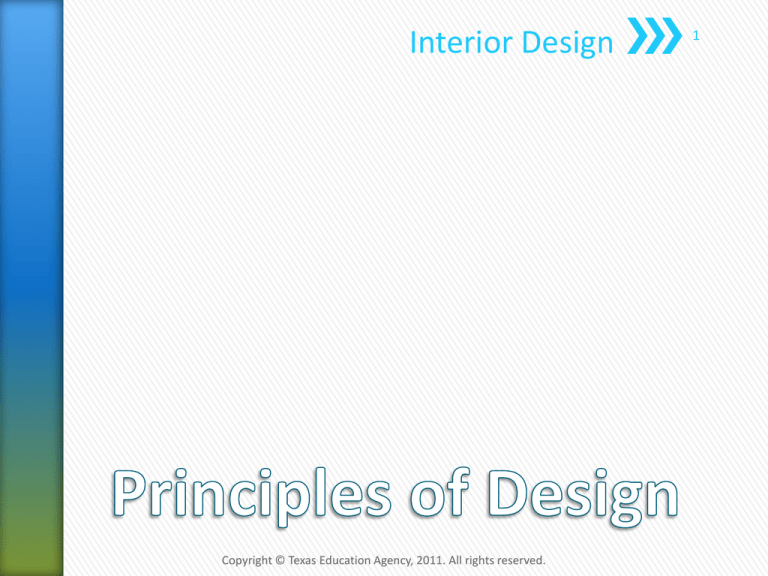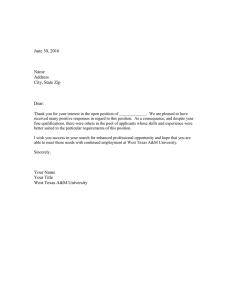
Interior Design
Copyright © Texas Education Agency, 2011. All rights reserved.
1
» Elements of Design
˃ Line
˃ Form
˃ Space
˃ Mass
˃ Texture
˃ Color
2
Copyright © Texas Education Agency, 2011. All rights reserved.
» Proportion
» Scale
» Balance
» Rhythm
» Emphasis
» Unity
» Variety
Copyright © Texas Education Agency, 2011. All rights reserved.
3
What principles of
design do you see
in this room?
4
Copyright © Texas Education Agency, 2011. All rights reserved.
45
Principles of Design
Proportion
Scale
5
Copyright Texas Education Agency, 2011. All rights reserved.
» The size relationships that can be found within an
object or design.
» The ratio of one part to another or one part to
the whole.
» Proportions often expressed as ratios
˃ Most people prefer rectangles to square
˃ Unequal divisions of space are more appealing than
equal divisions of space
˃ 3:5, 5:8, and 8:13 ratios are more effective
6
Copyright © Texas Education Agency, 2011. All rights reserved.
Which Coffee table do you think is in proportion?
Why?
A
B
7
Copyright © Texas Education Agency, 2011. All rights reserved.
8
Copyright © Texas Education Agency, 2011. All rights reserved.
» The relative size of an object in relation to other
objects.
» Scale of furnishings should relate to the space
they occupy to be visually pleasing.
» Scale of furnishings also applies to the size of
the person using the item.
9
Copyright © Texas Education Agency, 2011. All rights reserved.
10
Copyright © Texas Education Agency, 2011. All rights reserved.
» Visual Weight is the perception that an item
weighs more or less then it actually does.
˃ Thick lines, bold colors, rough textures and
large patterns add visual weight.
˃ Slender lines, light colors, smooth textures
and small patterns create a lighter visual
weight.
11
Copyright © Texas Education Agency, 2011. All rights reserved.
Principles of Design- Balance
Symmetrical
48
Asymmetrical
12
Copyright Texas Education Agency, 2011. All rights reserved.
» Two kinds of balance.
Symmetrical Balance
The amount, size or weight of objects on both
sides of a center point is equal.
Convey formality, dignity and calmness.
Asymmetrical Balance
Unequal objects or groups of objects appear to
be equal.
Informal
Copyright © Texas Education Agency, 2011. All rights reserved.
13
Symmetrical Balance
14
Copyright © Texas Education Agency, 2011. All rights reserved.
Asymmetrical Balance
15
Copyright © Texas Education Agency, 2011. All rights reserved.
Asymmetrical Balance
16
Copyright © Texas Education Agency, 2011. All rights reserved.
Is this symmetrical
or asymmetrical
balance?
17
Copyright © Texas Education Agency, 2011. All rights reserved.
51
Principles of Design- Rhythm
Repetition
Radiation
Gradation
Opposition
Transition
18
Copyright Texas Education Agency, 2011. All rights reserved.
» Occurs when an element of design (line, form, texture,
color) forms an organized pattern.
» Can add interest to a room but if overused can cause the
room to be boring.
» There are various ways to achieve rhythm.
˃ Repetition
˃ Radiation
˃ Gradation
˃ Opposition
19
˃ Transition
Copyright © Texas Education Agency, 2011. All rights reserved.
» Repetition- a repeated element (line, color,
shape form or pattern).
» The repetition may be an alternating pattern
» Leads the eye from one place to another
20
Copyright © Texas Education Agency, 2011. All rights reserved.
Repetition
21
Copyright © Texas Education Agency, 2011. All rights reserved.
» Radiation is when
lines move outward
from a central point.
22
Copyright © Texas Education Agency, 2011. All rights reserved.
» Gradation is when
objects increase or
decrease in size.
23
Copyright © Texas Education Agency, 2011. All rights reserved.
» Opposition is
when lines come
together to form
right angles.
24
Copyright © Texas Education Agency, 2011. All rights reserved.
» Transition is when
curved lines lead the
eye from one place to
another.
25
Copyright © Texas Education Agency, 2011. All rights reserved.
57
Principles of Design
Emphasis
Unity
Variety
26
Copyright Texas Education Agency, 2011. All rights reserved.
» Creating a center of interest or focal point in
a room.
» Can give order and direction to a room
˃ Everything else should relate to the emphasis
through color, texture, scale or theme.
» The item or feature should
˃ be dominant but not overpower the room
˃ not compete with other features
˃ Be worthy of the attention it will receive
27
Copyright © Texas Education Agency, 2011. All rights reserved.
1. What do you think
creates emphasis?
2. What is the first thing
you notice when
entering the room?
3. How is the focal point
tied into the other
elements in the room?
28
Copyright © Texas Education Agency, 2011. All rights reserved.
1. What do you think
creates emphasis?
2. What is the first thing
you notice when
entering the room?
3. How is the focal point
tied into the other
elements in the room?
29
Copyright © Texas Education Agency, 2011. All rights reserved.
» Unity is when all parts of a design relate to
one design idea.
˃ Consistent shape, color or line in design
elements
» Consistency of style
» You see the room as a whole instead of as a
collection of items.
30
Copyright © Texas Education Agency, 2011. All rights reserved.
31
Copyright © Texas Education Agency, 2011. All rights reserved.
» When different styles and materials are
combined.
» Styles and materials should be compatible.
» Unity with some variety creates interest.
» One common mistake is using a different
decorating style in each room of a small home.
32
Copyright © Texas Education Agency, 2011. All rights reserved.
33
Copyright © Texas Education Agency, 2011. All rights reserved.
What principles of
design do you see
in this room?
34
Copyright © Texas Education Agency, 2011. All rights reserved.

